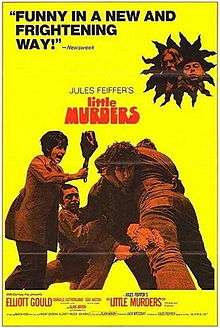Little Murders
| Little Murders | |
|---|---|
 | |
| Directed by | Alan Arkin |
| Produced by | Jack Brodsky |
| Written by | Jules Feiffer |
| Starring |
Elliott Gould Marcia Rodd Vincent Gardenia Elizabeth Wilson Jon Korkes John Randolph Doris Roberts Donald Sutherland Lou Jacobi Alan Arkin |
| Music by | Fred Kaz |
| Cinematography | Gordon Willis |
| Edited by | Howard Kuperman |
| Distributed by | 20th Century Fox |
Release dates | February 9, 1971 |
Running time | 108 minutes |
| Country | United States |
| Language | English |
| Budget | $1,340,000[1] |
| Box office | $1,500,000 (US/ Canada)[2] |
Little Murders is a 1971 black comedy film starring Elliott Gould and Marcia Rodd, directed by Alan Arkin[3] in his feature directorial debut. It is the story of a girl, Patsy (Rodd), who brings home her boyfriend, Alfred (Gould), to meet her severely dysfunctional family amidst a series of random shootings, garbage strikes and electrical outages ravaging their New York City neighborhood.
The film originated as a play written by cartoonist Jules Feiffer which was staged on Broadway in 1967 but which lasted only seven performances. This failure was followed by a successful London production by the Royal Shakespeare Company, directed by Christopher Morahan at the Aldwych Theatre.
It was then revived Off-Broadway in 1969 by Circle in the Square in New York City, directed by Arkin with a cast that included Linda Lavin, Vincent Gardenia, and Fred Willard. That production ran for 400 performances, and won Feiffer an Obie Award. Lavin won the 1969 Outer Critics Circle Award for Best Performance.
Gould bought the film rights and co-produced the movie with Jack Brodsky, who received the producer credit. When Feiffer adapted the play for film he added new scenes, including new characters such as the parents of the character of Alfred Chamberlain (played by John Randolph and Doris Roberts).
The film opened to a lukewarm review by Roger Greenspan,[4] and a more positive one by Vincent Canby[5] in the New York Times. Roger Ebert's review in the Chicago Sun Times was more enthusiastic, saying, "One of the reasons it works, and is indeed a definitive reflection of America's darker moods, is that it breaks audiences down into isolated individuals, vulnerable and uncertain."[6]
Plot
Patsy Newquist is a 27-year-old interior designer who lives in a New York City rife with street crime, noise, obscene phone calls, power blackouts and unsolved homicides. When she sees a defenseless man being attacked by street thugs, she intervenes, but is surprised when the passive victim doesn't even bother to thank her. She ends up attracted to the man, Alfred Chamberlain, a photographer, but finds that he is emotionally vacant, barely able to feel pain or pleasure. He permits muggers to beat him up until they get tired and go away.
Patsy is accustomed to molding men into doing her bidding. Alfred is different. When she brings him home to meet her parents and brother, he is almost non-verbal, except to tell her that he doesn't care for families. He learns that Patsy had another brother who was murdered for no known reason. Patsy's eccentric family is surprised when she announces their intention to wed, then amazed when their marriage ceremony conducted by the existential Rev. Dupas turns into a free-for-all.
Determined to discover why her new husband is the way he is, Patsy coaxes Alfred into traveling to Chicago to visit his parents. He hasn't seen them since he was 17, but asks them to help with a questionnaire about his childhood at Patsy's request.
Alfred ultimately agrees to try to become Patsy's kind of man, the kind willing to "fight back". The instant that happens, a sniper's bullet kills Patsy, again for no apparent reason. A blood-splattered Alfred goes to her parents' apartment, New Yorkers barely noticing his state. He descends into a silent stupor, Patsy's father even having to feed him.
A ranting, disturbed police detective, Lt. Practice, drops by, almost unable to function due to the number of unsolved murders in the city. After he leaves, Alfred goes for a walk in the park. He returns with a rifle, which he doesn't know how to load. Patsy's father shows him how. Then the two of them, along with Patsy's brother, take turns shooting people down on the street.
Cast
- Elliott Gould as Alfred Chamberlain
- Marcia Rodd as Patsy Newquist
- Vincent Gardenia as Patsy's Father (reprising 1969 stage role)
- Elizabeth Wilson as Patsy's Mother (reprising 1969 stage role)
- Jon Korkes as Patsy's Brother (reprising 1969 stage role)
- John Randolph as Alfred's Father
- Doris Roberts as Alfred's Mother
- Donald Sutherland as the Rev. Henry Dupas
- Lou Jacobi as Judge Stern
- Alan Arkin as Lt. Practice
In popular culture
- On the album Cowbirds and Cuckoos by Ryland Bouchard there is a song titled "Little Murders".
- On the popular AMC television show Mad Men, set in the 1960s, the character of Megan Draper auditions for the original stage production.
- Dave Sim has stated that in the comic book Cerebus, the character of The Judge is based on Lou Jacobi's portrayal from this film.
See also
References
- ↑ Solomon, Aubrey. Twentieth Century Fox: A Corporate and Financial History (The Scarecrow Filmmakers Series). Lanham, Maryland: Scarecrow Press, 1989. ISBN 978-0-8108-4244-1. p256
- ↑ Solomon p 231. Please note figures are rentals not total gross.
- ↑ "Little Murders". Turner Classic Movies. Retrieved April 19, 2016.
- ↑ 'Little Murders' Is Back As Film Arkin Directed
- ↑ Canby, Vincent (February 21, 1971). "What's So Funny? 'Murders'". New York: New York Times. p. D1.
"Little Murders" succeeds, at times triumphantly, and it does everything more or less backwards.
- ↑ Roger Ebert's review
External links
- Little Murders at the Internet Movie Database
- Little Murders (1969 production) in the Lortel Archives